Gongmin of Goryeo
King Gongmin of Goryeo (23 May 1330 – 27 October 1374) ruled Goryeo Korea from 1351 to 1374. He was the son second of King Chungsuk. In addition to his various Korean names, he bore the Mongolian name Bayan Temür (伯顔帖木兒).
| King Gongmin of Goryeo 고려 공민왕 | |||||
|---|---|---|---|---|---|
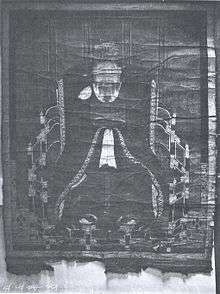 | |||||
| King of Goryeo | |||||
| Reign | 1351–1374 | ||||
| Predecessor | King Chungjeong of Goryeo | ||||
| Successor | King U of Goryeo | ||||
| Born | 23 May 1330 | ||||
| Died | 27 October 1374 (aged 44) | ||||
| Burial | |||||
| Consort | Queen Indeok Queen Sunjeong | ||||
| Issue | King U of Goryeo | ||||
| |||||
| House | House of Wang | ||||
| Father | King Chungsuk of Goryeo | ||||
| Mother | Queen Gongwon | ||||
| Religion | Buddhism | ||||
| Gongmin of Goryeo | |
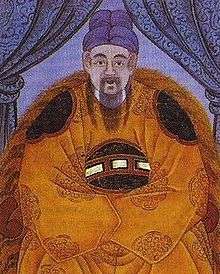 | |
| Korean name | |
|---|---|
| Hangul | |
| Hanja | |
| Revised Romanization | Gongmin wang |
| McCune–Reischauer | Kongmin wang |
| Pen name | |
| Hangul | |
| Hanja | |
| Revised Romanization | Ijae or Ikdang |
| McCune–Reischauer | Ijae or Iktang |
| Birth name | |
| Hangul | |
| Hanja | |
| Revised Romanization | Wang Jeon, earlier Wang Gi |
| McCune–Reischauer | Wang Chŏn, earlier Wang Ki |
| Sino-Korean Mongolian name | |
| Hangul | |
| Hanja | |
| Revised Romanization | Baegancheopmoga |
| McCune–Reischauer | Paegan Ch'ŏpmoga |
| Monarchs of Korea Goryeo |
|---|
|
Biography
Early life
Goryeo had been a semi-autonomous vassal state under the overlordship of the Mongol Yuan dynasty since the Mongol invasions of Korea in the 13th century. Starting with King Chungnyeol, prospective rulers of Korea married Mongolian princesses and were customarily sent to the Yuan Court, in effect, as hostages. As per this custom, King Gongmin spent many years in the Yuan court, being sent there in 1341, before ascending the Korean throne. He married a Mongolian princess who became Queen Noguk. The Yuan dynasty began to crumble during the mid-14th century, and was eventually conquered and replaced by the Ming dynasty in 1368.
Reign
With the disintegration of Yuan, which had influenced the Korean peninsula since the Mongol invasion of Korea of 1238, King Gongmin began efforts to reform Goryeo government. His first act was to remove all pro-Mongol aristocrats and military officers from their positions. These deposed people formed a dissident faction which plotted an unsuccessful coup against the king. High official Jo Il-shin even tried to take over the government, but this rebellion was put down by general Choi Young.
During the Mongol invasions of Korea, between the 1250s and the 1270s, the Mongols had annexed the northern provinces of Korea and incorporated them into their empire as Ssangseong (쌍성총관부, 雙城總管府) and Dongnyeong Prefectures (동녕부, 東寧府). In 1356, the Goryeo army retook these provinces partly thanks to the defection of Yi Ja-chun, a minor Korean official in the service of the Mongols in Ssangseong, and his son, Yi Seong-gye. In addition, Generals Yi Seong-gye and Ji Yongsu led a campaign into Liaoyang.
Another issue was the question of land holdings. The land-grant system had broken down, and Mongol-favoured officials, along with a handful of landed gentry, owned the vast majority of agricultural land, which was worked by tenant farmers and bondsmen. However, King Gongmin's attempt at land reform was met with opposition and subterfuge from those officials who were supposed to implement his reforms, as they were landowners themselves.
The Wokou were also a problem encountered during King Gongmin's reign. The Wokou had been troubling the peninsula for some time and had become well-organized military marauders raiding deep into the country, rather than the "hit-and-run" bandits they started as. Generals Choi Young and Yi Seong-gye were called upon by King Gongmin to combat them.
Additionally, King Gongmin grappled with the Red Turban troops, who invaded Goryeo twice during his reign (first in 1359 and again in 1361). In 1361, the Red Turban troops occupied Kaesong for a short period of time. After Kaesong was recaptured by Generals Choe Yeong, Yi Seong-gye, Jeong Seun, and Yi Bang-sil, few Red Turban troops managed to escape with their lives.
During the reign of King Gongmin, a Goryeo diplomat, Mun Ik-jeom, stationed in China managed to smuggle cotton seeds into Goryeo, introducing them to the Korean peninsula for the first time.
Although the relationship between Queen Noguk and the king was very close, they failed to conceive an heir for many years. Despite suggestions of taking a second wife, King Gongmin ignored these requests. The king was also known to have entered into pederastic relationships with several court catamites, or chajewi, and the names of five of these are recorded as: Hong Yun, Han An, Kwon Chin, Hong Kwan, and No Son.[1] Queen Noguk became pregnant but died from complications with childbirth in 1365.[2] Her death led to King Gongmin's depression and mental instability. King Gongmin became indifferent to politics and entrusted the great tasks of state to Pyeonjo, a Buddhist monk who was born as the son of a princess and a slave. Judging him as clever, King Gongmin renamed Pyeonjo as Shin Don. Having the full confidence of King Gongmin, Shin Don tried to reform the society of Goryeo. In 1365, King Gongmin gave Pyeonjo the nickname "Cheonghan Geosa" and the noble title of Jinpyeonghu (Chinpyŏng Marquess). After six years, Shin Don lost his position and King Gongmin had him executed in 1371.
Goryeo's entrenched bureaucracy never forgave King Gongmin for his reform efforts. They interpreted his policy of cutting all ties with the Yuan and establishing relations with Ming China as a direct threat to their status and feared that further attempts at reform might yet be made. Kaesong's deposed pro-Mongol faction battled to protect its position and hoped to renew ties with the Mongols who had helped them gain and hold their wealth in the first place.
Death
Some time before his death, King Gongmin found out that one of his concubines had an affair with a young man named Hong Ryun (홍륜), which led to King Gongmin's anger. Before King Gongmin could kill him, Hong Ryun and Choe Man-saeng (최만생) killed the King in his sleep in 1374.
After his death, a high official Yi In-im assumed the helm of the government and enthroned eleven-year-old, King U.
As an artist
King Gongmin was well known for his artistic skills, and he is referred to as one of the best artists of the Goryeo period. He was also well known for his calligraphy works.
Example of his works are:
- "Painting of A Hunt in the Mountains of Heaven" 《天山大獵圖 (천산대렵도 Cheonsan Daeryeop Do)》
- "Painting of Two Sheep" 《二羊圖 (이양도 I Yang Do)》
- "Portrait of Princess Noguk" 《魯國大長公主真 (노국대장공주진 Noguk Daejang Gongju Jin)》
- "Portrait of Yeom Je-shin 《廉悌臣象 (염제신상 Yeom Je-shin Sang)》, 1370's
- "Portrait of Sohn Hong-ryang" 《孫洪亮象 (손홍량상 Sohn Hong-ryang Sang)》
- "Portrait of Śākyamuni's Leaving Mountain" 《釋迦出山像 (석가출산상 Seokga Chulsan Sang)》
- "Landscape of Epang Palace" 《阿房宮圖 (아방궁도 Ahbanggung Do)》
- "Landscape of Hyeonreung" 《玄陵山水圖 (현릉산수도 Hyeonreung Sansu Do)》
- "Portrait of Bodhidharma Crossing a River with a Broken Branch" 《達磨折蘆渡江圖 (달마절로도강도 Dalma Jeollo Dogang Do)》
- Dongjabohyeon Yugabaeksang Do《童子普賢六牙白象圖 (동자보현육아백상도)》
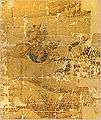 Cheonsan Daeryeop Do, "Portrait of A Hunt in the Mountains of Heaven".
Cheonsan Daeryeop Do, "Portrait of A Hunt in the Mountains of Heaven".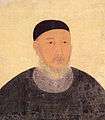 Yeon Je-shin's Portrait, painted by King Gongmin around the 1370s.
Yeon Je-shin's Portrait, painted by King Gongmin around the 1370s.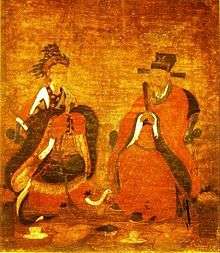 King Gongmin and Queen Noguk
King Gongmin and Queen Noguk
Family
- Father: King Chungsuk of Goryeo (30 July 1294 – 3 May 1339) (고려 충숙왕)
- Grandfather: King Chungseon of Goryeo (20 October 1275 – 23 June 1325) (고려 충선왕)
- Grandmother: Royal Consort Yasokjin Ui-Bi (? – 18 July 1316) (의비 야속진)
- Mother: Queen Gongwon of the Namyang Hong clan (18 July 1298 – January 1380) (공원왕후 홍씨)[3]
- Grandfather: Hong Gyu (1242 – 23 June 1316) (홍규)
- Grandmother: Lady Kim of the Gwangju Kim clan (광주 김씨)
- Consorts:
- Queen Indeok of the Borjigin clan (? – 8 March 1365) (인덕왕후)[4][5][6]
- Queen Sunjeong of the Goksan Han clan (? – 1376) (순정왕후 한씨)
- Royal Consort Hye-Bi of the Gyeongju Lee clan (? – 3 February 1408) (혜비 이씨)[7][8][9][10]
- Royal Consort Ik-Bi of the Kaesong Wang clan (익비 왕씨)[11][12]
- Royal Consort Shin-Bi of the Paju Yeom clan (신비 염씨)[9][13][14]
- Royal Consort Jeong-Bi of the Jukju Ahn clan (? – 1428) (정비 안씨)[15][9][16][17][18]
- Royal Concubine Ban-Ya (시비 반야)
- King U of Goryeo (25 July 1365 – 31 December 1389) (고려 우왕)
Popular depictions
- Portrayed by Im Hyuk in the 1983 KBS TV series Foundation of the Kingdom.
- Portrayed by Jeong Bo-seok in the 2005–2006 MBC TV series Shin Don.
- Portrayed by Joo Jin-mo in the 2008 film A Frozen Flower.
- Portrayed by Ryu Deok-hwan in the 2012 SBS TV series Faith.
- Portrayed by Ryu Tae-joon in the 2012–2013 SBS TV series The Great Seer.
- Portrayed by Kim Myeong-su in the 2014 KBS TV series Jeong Do-jeon
See also
- List of Korea-related topics
- History of Korea
- List of Korean monarchs
- Tomb of King Kongmin
- Korea under Yuan rule
References
- 공민왕 (in Korean). Doosan Encyclopedia.
Notes
- Kim, Young‐Gwan; Hahn, Sook-Ja (2006). "Homosexuality in ancient and modern Korea". Culture, Health & Sexuality: An International Journal for Research, Intervention and Care. 8 (1): 59–65. doi:10.1080/13691050500159720. PMID 16500825.
- Weatherford, Jack (2010). The secret history of the Mongol queens : how the daughters of Genghis Khan rescued his empire (1st ed.). New York: Crown Publishers. p. 127. ISBN 9780307407153. OCLC 354817523.
- Second daughter of Hong Gyu (홍규, 1242–1316). Younger sister of Lady Sunhwa, Consort Won (순화원비, ? – August 13, 1306), one of King Chungseon (Chungsuk's predecessor)'s concucbines.
- Daughter of Bayr Temür (孛羅帖木兒), only son of Borjigin Amüge (孛兒只斤阿木哥, ?-1324), eldest son of Borjigin Darmabala (孛兒只斤答剌麻八剌, 1264–1292), second son of Borjigin Činkim ((孛兒只斤真金, 1243-January 05, 1286), second son of Kublai Khan).
- Niece of Princess Joguk (조국장공주, 1308-October 20, 1325), only daughter of Borjigin Amüge (孛兒只斤阿木哥); King Chungsuk's second Yuan bride after the first, Princess Bukguk (복국장공주), Esen Temür (也先帖木兒)'s daughter and Kublai's granddaughter, died in 1319.
- Married King Gongmin in 1349, after an earlier Yuan bride, Princess Seungeui (승의공주) was promptly returned.
- Daughter of Lee Je-hyeon (이제현) & Lady Suchonguk of the Park clan (수춘국부인 박씨).
- Married King Gongmin in April 24, 1359.
- Three of the royal consorts were placed under suspicion of having intimate relations with two of King Gongmin's pederastic bodyguards Han Ahn (한안) & Hong Ryun (홍륜), and were later kicked out of the palace.
- Also known by her title "Lady Hyehwa" (혜화궁주), posthumously granted (along with Consort Shin) by King Taejong of Joseon on her death during the 8th year of King Taejong of Joseon's rule.
- Originally from the Gaeseong Wang clan (개성 왕씨)
- Adoptive daughter of Wang Ui (왕의, dates unknown), Prince Deokpung (덕풍군) (Wang Ki (왕기, 1021–1069) Prince Jeongggan (정간왕)'s son; King Hyeonjong & Queen Wonhye's second son).
- Eldest daughter of Yeom Je-shin (염제신, October 30, 1304-March 18, 1382), whose portrait was done by King Gongmin himself.
- Posthumously restored to her title in September 22, 1374 (23rd year of King Gongmin).
- Also known as Royal Dowager Queen Jeongsuk (정숙왕대비) on her stepsons King U & King Chang's rule.
- Daughter of Ahn Geuk-in (안극인), Prince Jeukseong (죽성군).
- Aunt of Consort Hyeon (현비, dates unknown), one of King U's concubines; daughter of Ahn Seuk-ro (안숙로), her younger brother.
- Also known by her title "Lady Uihwa" (의화궁주), posthumously granted by Sejong on her death (10th year of Sejong's rule).
Gongmin of Goryeo House of Wang Born: 23 May 1330 Died: 27 October 1374 | ||
| Regnal titles | ||
|---|---|---|
| Preceded by King Chungjeong |
King of Goryeo 1351–1374 |
Succeeded by King U |